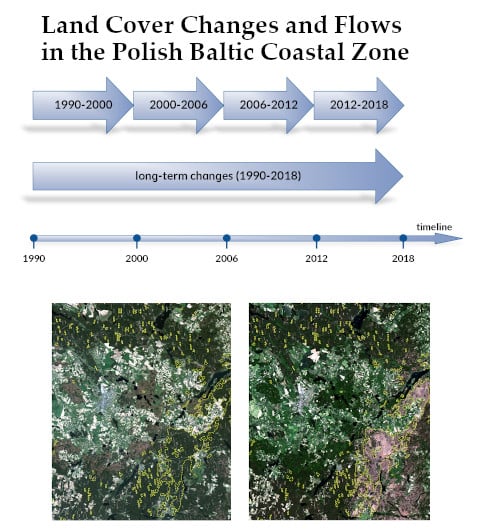Land Cover Changes and Flows in the Polish Baltic Coastal Zone: A Qualitative and Quantitative Approach
Abstract
1. Introduction
2. Materials and Methods
2.1. Area Description
2.2. Data used
2.2.1. CORINE Land Cover
2.2.2. Satellite and Aerial Data
2.2.3. Administrative Boundaries
2.3. Methods Applied
2.3.1. Verification of Land Cover Changes
2.3.2. Land Cover Changes Quantification
- What were the main land cover changes and land cover flows in the Polish Baltic coastal zone during the last three decades? Were they in line with the country average?
- How did the changes in land cover affect the landscape in legally protected areas?
- Is the spatial pattern of land cover changes clustered, dispersed, or random? Which regions are most affected by land cover changes?
- How, positively or negatively, do changes in land cover affect the progress towards SDG?
2.4. Workflow
3. Results
3.1. CLC Change Data Veryfication
3.2. Overview of Land Cover and Land Cover Net Changes
3.3. Spatial Pattern and Density of Land Cover Changes
3.4. Land Cover Flows
3.5. Progress towards SDGs 11 and 15
4. Discussion
- urban and infrastructure expansion resulting in a loss of productive soils and landscape fragmentation;
- continuous decrease of agricultural areas and, as a consequence, farmland abandonment and biodiversity loss;
- intensification of forest land use, leading to a declining quality of forest ecosystems.
5. Conclusions
Author Contributions
Funding
Acknowledgments
Conflicts of Interest
Appendix A

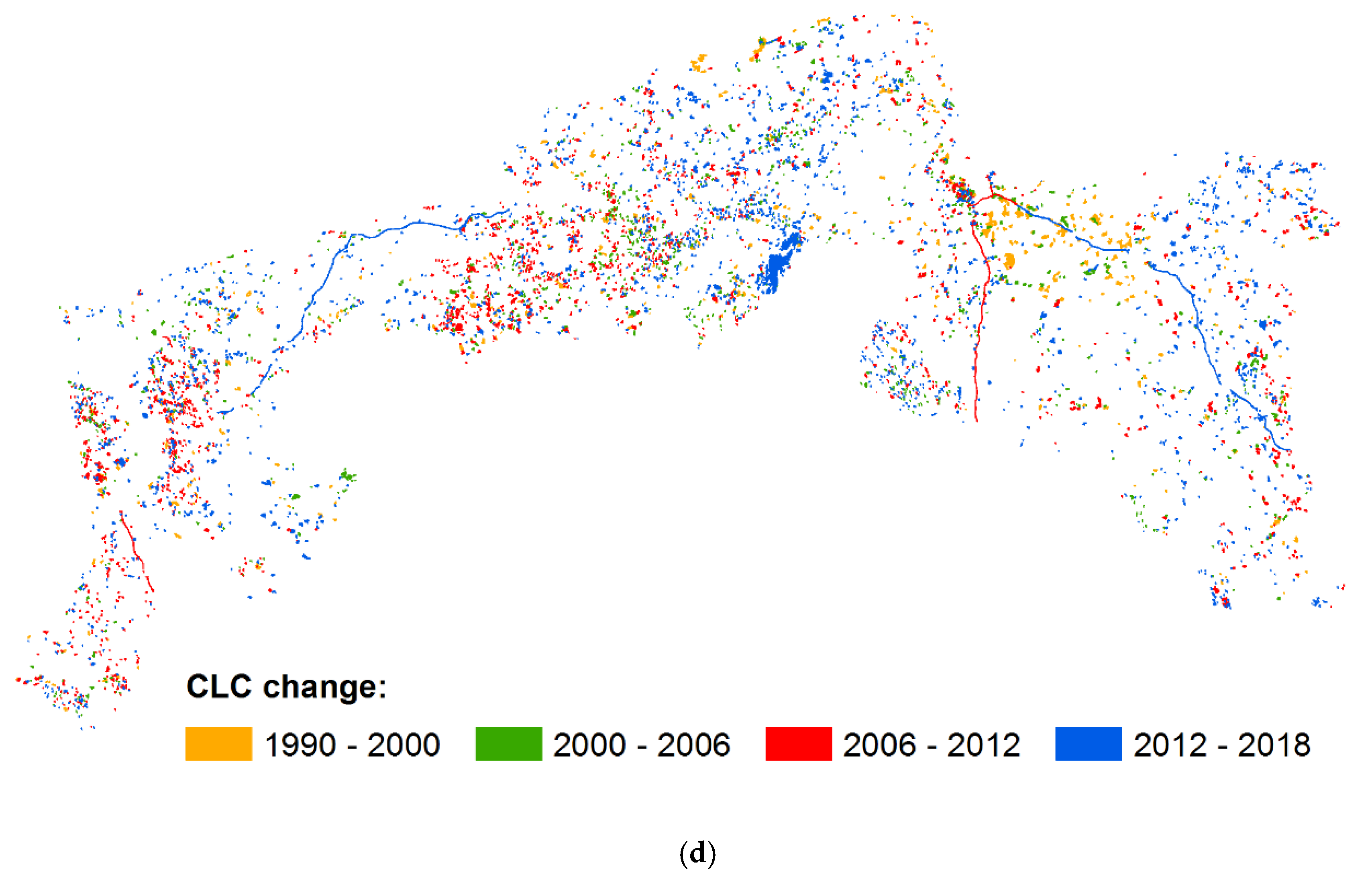
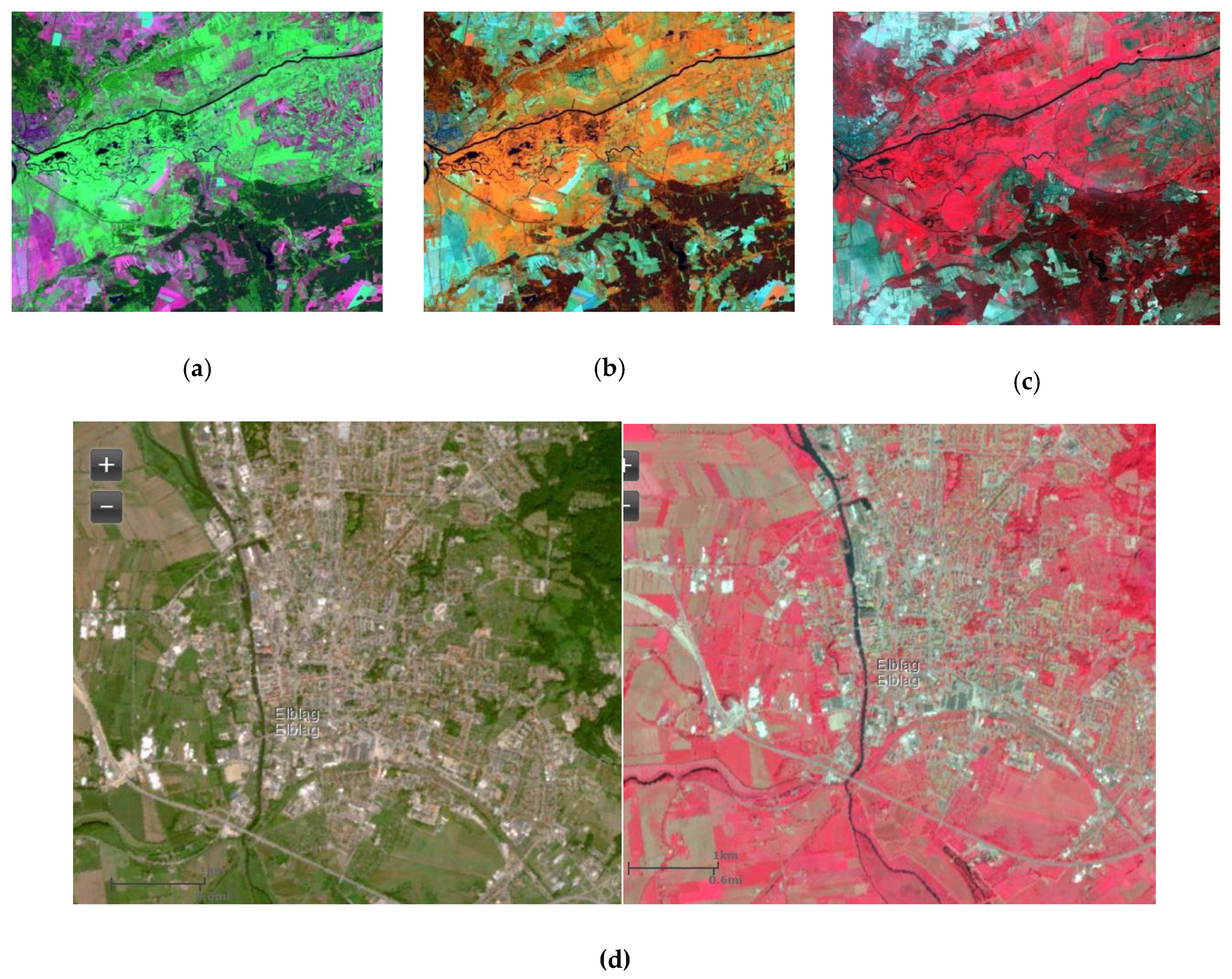
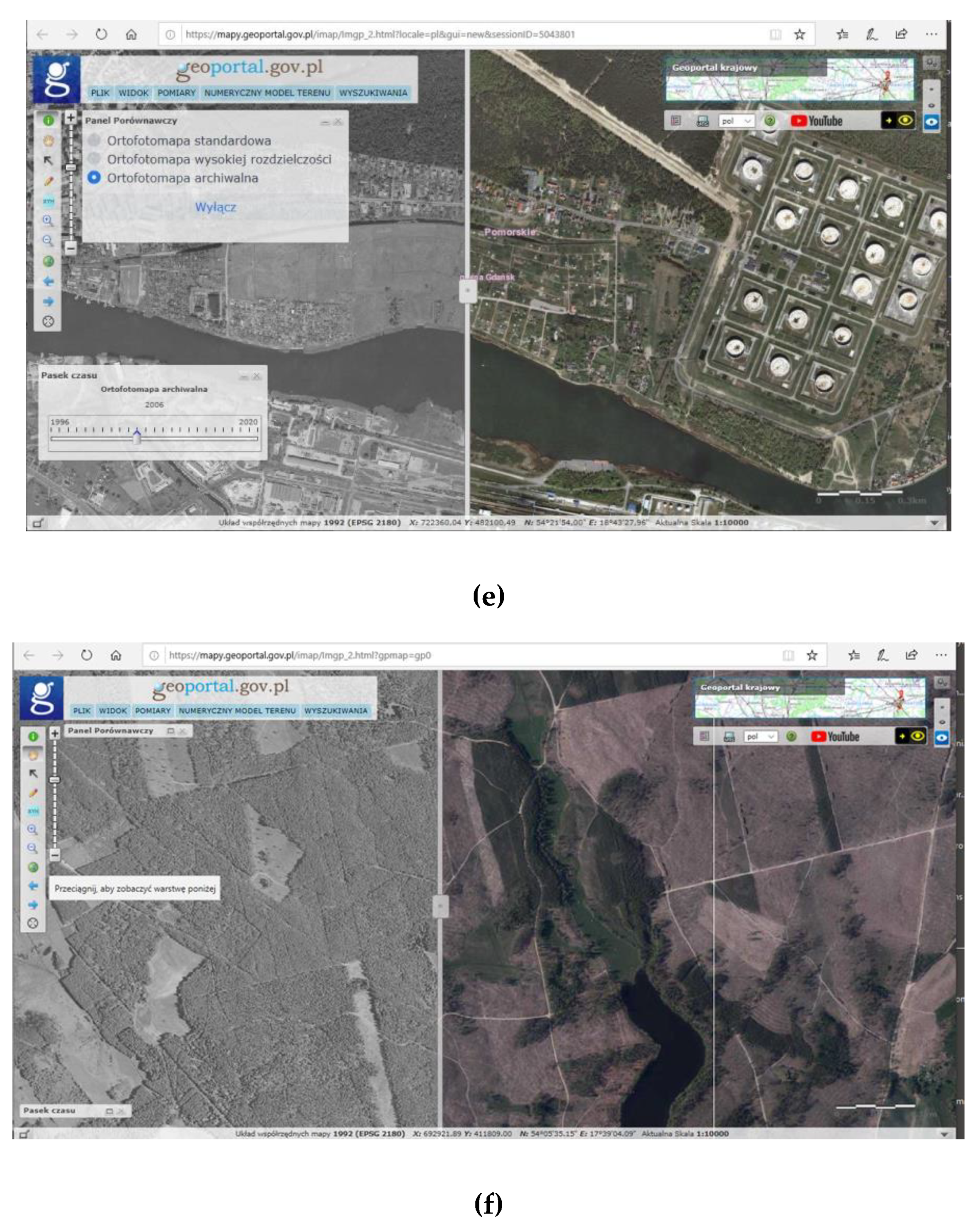
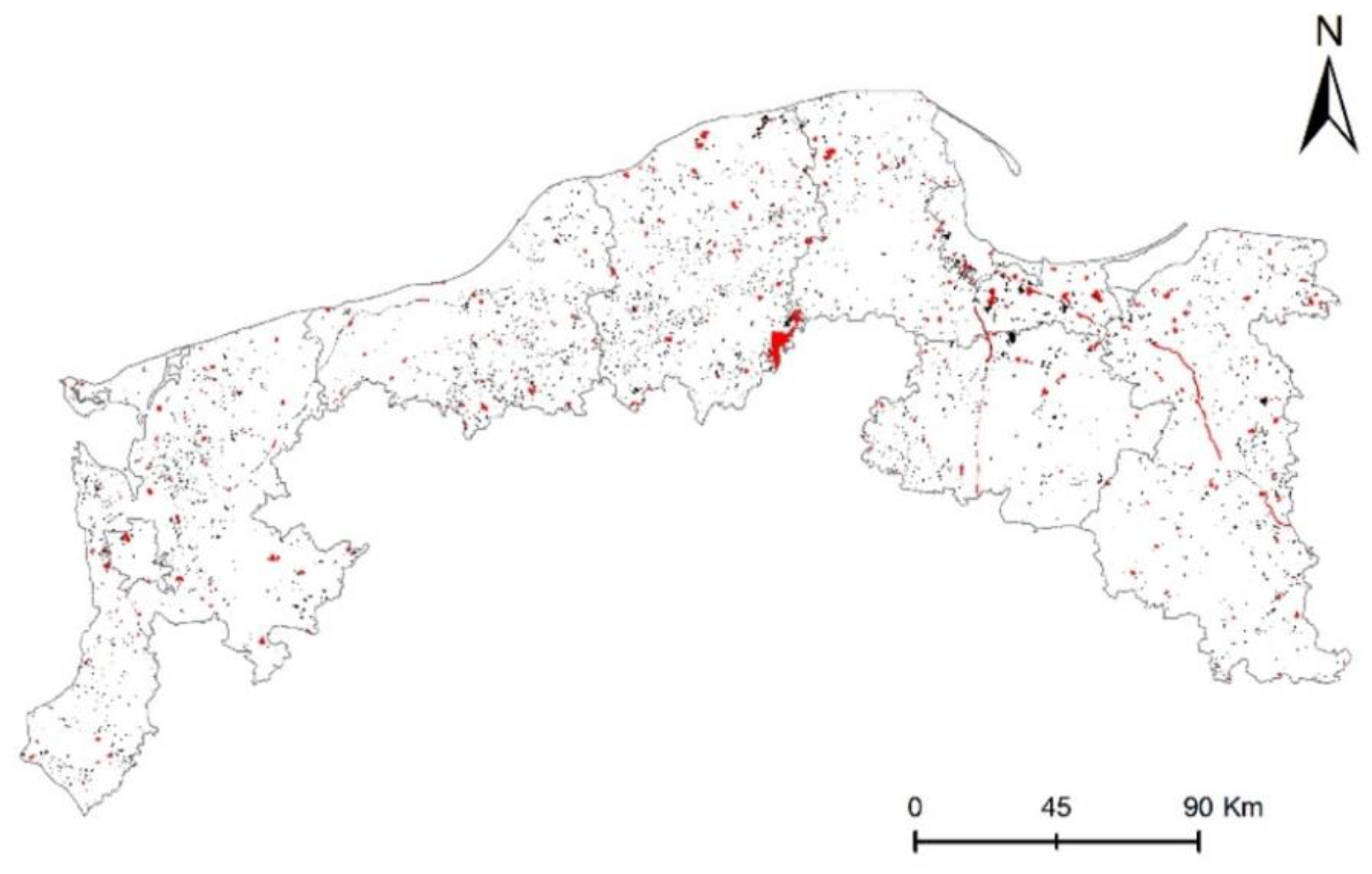
References
- Strandberg, G.; Kjellström, E. Climate Impacts from Afforestation and Deforestation in Europe. Earth Interact. 2019, 23, 1–27. [Google Scholar] [CrossRef]
- Sagan, C.; Toon, O.B.; Pollack, J.B. Anthropogenic Albedo Changes and the Earth’s Climate. Science 1979, 206, 1363–1368. [Google Scholar] [CrossRef]
- Chun, J.; Kim, C.-K.; Kang, W.; Park, H.; Kim, G.; Lee, W.-K. Sustainable Management of Carbon Sequestration Service in Areas with High Development Pressure: Considering Land Use Changes and Carbon Costs. Sustainability 2019, 11, 5116. [Google Scholar] [CrossRef]
- Vitousek, P.M.; Mooney, H.A.; Lubchenco, J.; Melillo, J.M. Human Domination of Earth’s Ecosystems. Science 1997, 277, 494–499. [Google Scholar] [CrossRef]
- Sala, O.E.; Chapin, F.S.; Armesto, J.J.; Berlow, E.; Bloomfield, J.; Dirzo, R.; Huber-Sanwald, E.; Huenneke, L.F.; Jackson, R.B.; Kinzig, A.; et al. Global Biodiversity Scenarios for the Year 2100. Science 2000, 287, 1770–1774. [Google Scholar] [CrossRef] [PubMed]
- Trimble, S.W.; Crosson, P.U.S. Soil Erosion Rates-Myth and Reality. Science 2000, 289, 248–250. [Google Scholar] [CrossRef]
- Lambin, E.F.; Geist, H.J.; Lepers, E. Dynamics of Land-Use and Land-Cover Change in Tropical Regions. Annu. Rev. Environ. Resour. 2003, 28, 205–241. [Google Scholar] [CrossRef]
- Dorocki, S.; Raźniak, P.; Winiarczyk-Raźniak, A. Changes in the command and control potential of European cities in 2006–2016. Geogr. Pol. 2019, 92, 275–288. [Google Scholar] [CrossRef]
- Esposito, M.A.; Perdigao, V.; Christensen, S.; Di Cura, A. The LaCoast Atlas: Land Cover Changes in European Coastal Zones; EU—European Commission Publication Office, Joint Research Centre: Milan, Italy, 2000. [Google Scholar]
- Antso, K.; Palginõmm, V.; Szava-Kovats, R.; Kont, A. Dynamics of Coastal Land Use over the Last Century in Estonia. J. Coast. Res. 2011, SI 64, 1769–1773. [Google Scholar]
- Neumann, B.; Ott, K.; Kenchington, R. Strong sustainability in coastal areas: A conceptual interpretation of SDG 14. Sustain. Sci. 2017, 12, 1019–1035. [Google Scholar] [CrossRef]
- Merkens, J.-L.; Reimann, L.; Hinkel, J.; Vafeidis, A.T. Gridded population projections for the coastal zone under the Shared Socioeconomic Pathways. Glob. Planet. Chang. 2016, 145, 57–66. [Google Scholar] [CrossRef]
- Merkens, J.-L.; Vafeidis, A. Using Information on Settlement Patterns to Improve the Spatial Distribution of Population in Coastal Impact Assessments. Sustainability 2018, 10, 3170. [Google Scholar] [CrossRef]
- Neumann, B.; Vafeidis, A.T.; Zimmermann, J.; Nicholls, R.J. Correction: Future Coastal Population Growth and Exposure to Sea-Level Rise and Coastal Flooding—A Global Assessment. PLoS ONE 2015, 10, e0131375. [Google Scholar] [CrossRef]
- Eurostat. Eurostat regional yearbook 2011, chapter 13 Coastal Region. In Eurostat Regional Yearbook 2011; Publications Office of the European Union: Luxembourg, 2011; pp. 170–183. [Google Scholar]
- Institute of Meteorology and Water Management. Assessment of Actual and Future Climate Changes on Polish Coastal Zone and Its Ecosystem. Available online: https://nfosigw.gov.pl/download/gfx/nfosigw/pl/nfoekspertyzy/858/210/1/2014-424.pdf (accessed on 19 December 2019).
- Fortuniak, K. Stochastyczne i deterministyczne aspekty zmienności wybranych elementów klimatu Polski. Acta Univ. Lodz. Folia Geogr. Phys. 2000, 4, 1–139. [Google Scholar]
- Neumann, T.; Schernewski, G.; Hofstede, J. Global Change and Baltic Coastal Zones; Coastal Research Library; Springer: Dordrecht, The Netherlands, 2011; Volume 1. [Google Scholar] [CrossRef]
- Zaucha, J. Territorial Cohesion—Baltic Sea Region Examples; Baltic 21 Series; s.Pro Sustainable Projects: Berlin, Germany, 2011; Volume 2. [Google Scholar]
- Eurostat. Methodological Manual on Territorial Typologies—2018 Edition; Publications Office of the European Union: Luxembourg, 2019. [Google Scholar] [CrossRef]
- GUS. Statystyka Regionalna—Regional Statistic. Available online: http://stat.gov.pl/statystyka-regionalna/jednostki-terytorialne/klasyfikacja-nuts/ (accessed on 13 November 2019).
- Tylkowski, J. The tendencies of bioclimatic conditions changes and dynamics occurrence of thermally stimulus weather events in the Polish Baltic coastal zone. J. Educ. Health Sport 2017, 7, 467–480. [Google Scholar] [CrossRef]
- Pruszak, Z.; Zawadzka, E. Vulnerability of Poland’s Coast to Sea-Level Rise. Coast. Eng. J. 2005, 47, 131–155. [Google Scholar] [CrossRef]
- Bossard, M.; Feranec, J.; Otahel, J. Technical Report No 40/2000 CORINE Land Cover Technical Guide—Addendum 2000; EEA: Copenhagen, Denmark, 2000. [Google Scholar]
- Bielecka, E.; Jenerowicz, A. Intellectual Structure of CORINE Land Cover Research Applications in Web of Science: A Europe-Wide Review. Remote Sens. 2019, 11, 2017. [Google Scholar] [CrossRef]
- GIOŚ. CORINE Land Cover-CLC. Available online: http://clc.gios.gov.pl/ (accessed on 30 November 2019).
- Główny Urząd Geodezji i Kartografii. Geoportal Infrastruktury Informacji Przestrzennej. Available online: Geoportal.gov.pl (accessed on 10 February 2020).
- Copernicus Proramme. Copernicus Land Monitoring Service. Available online: https://land.copernicus.eu/imagery-in-situ (accessed on 10 February 2020).
- European Space Agency. Copernicus Open Access Hub. Available online: https://scihub.copernicus.eu/ (accessed on 10 February 2020).
- U.S. Geological Survey. Landsat Data Access. Available online: https://www.usgs.gov/land-resources/nli/landsat/landsat-data-access (accessed on 20 April 2020).
- European Commission Eurostat. NUTS. Available online: https://ec.europa.eu/eurostat/web/gisco/geodata/reference-data/administrative-units-statistical-units/nuts (accessed on 10 December 2019).
- European Parliament. Regulation (EC) No 1059/2003 of the European Parliament and of the Council of 26 May 2003 on the Establishment of a Common Classification of Territorial Units for Statistics (NUTS); OJ L 154; The European Parliament: Brussels, Belgium, 2003; pp. 1–41. [Google Scholar]
- Sun, W.; Chen, B.; Messinger, D.W. Nearest-neighbor diffusion-based pan-sharpening algorithm for spectral images. Opt. Eng. 2014, 53, 013107. [Google Scholar] [CrossRef]
- Lambin, E.F.; Rounsevell, M.D.A.; Geist, H.J. Are agriculturala land-use model able to predict changes in land-use intensity. Agric. Ecosyst. Environ. 2000, 82, 321–331. [Google Scholar] [CrossRef]
- Feranec, J.; Jaffrain, G.; Soukup, T.; Hazeu, G. Determining changes and flows in European landscapes 1990–2000 using CORINE land cover data. Appl. Geogr. 2010, 30, 19–35. [Google Scholar] [CrossRef]
- Ripley, B.D. The second-order analysis of stationary point processes. J. Appl. Probab. 1976, 13, 255–266. [Google Scholar] [CrossRef]
- Deng, Y.; Liu, J.; Liu, Y.; Luo, A. Detecting Urban Polycentric Structure from POI Data. ISPRS Int. J. GeoInf. 2019, 8, 283. [Google Scholar] [CrossRef]
- Silverman, B.W. Density Estimation for Statistics and Data Analysis; Chapman and Hall/CRC: New York, NY, USA, 1986. [Google Scholar]
- Gini, C. On the Measure of Concentration with Special Reference to Income and Statistics. Color. Coll. Publ. Gen. Ser. 1936, 208, 73–79. [Google Scholar]
- European Environment Agency. The Thematic Accuracy of Corine Land Cover 2000: Assessment Using LUCAS (Land Use/Cover Area Frame Statistical Survey); EEA Technical Report No 7/2006; EEA Publication Office: Copenhagen, Denmark, 2006; p. 85. Available online: https://www.eea.europa.eu/publications/technical_report_2006_7 (accessed on 5 May 2020).
- GUS. Forestry; Statistical Publishing Establishment: Warsaw, Poland, 2017. Available online: www.stat.gov.pl (accessed on 12 December 2019).
- Agarwal, C.; Green, G.M.; Grove, J.M.; Evans, T.P.; Schweik, C.M. A Review and Assessment of Land-Use Change Models: Dynamics of Space, Time, and Human Choice; General Techical Report NE-297; U.S. Northeastern Research Station, Forest Service, Department of Agriculture: Newtown Square, PA, USA, 2002; p. 61. [Google Scholar]
- Guerra, C.A.; Rosa, I.M.D.; Pereira, H.M. Change versus stability: Are protected areas particularly pressured by global land cover change? Landsc. Ecol. 2019, 34, 2779–2790. [Google Scholar] [CrossRef]
- Matyka, M. Analiza regionalnego zróżnicowania zmian w użytkowaniu gruntów w Polsce. Pol. J. Agron. 2012, 10, 16–20. [Google Scholar]
- Woch, M.; Konarski, M. Ewolucja Prawa Miejscowego Jednostek Samorządu Terytorialnego w Polsce; Wydawnictwo Marek Woch: Warszawa, Poland, 2014. [Google Scholar]
- Bielecka, E.; Ciołkosz, A. Land Cover Structure in Poland and its changes in the last decade of 20th Century. Ann. Geomat. 2004, 2, 81–93. [Google Scholar]
- EEA. Landscapes in Transition An Account of 25 Years of Land Cover Change in Europe; EEA Report No 10/2017; Publications Office of the European Union: Luxembourg, 2017; Available online: https://www.eea.europa.eu/publications/landscapes-in-transition (accessed on 28 November 2019).
- Hosciło, A.; Tomaszewska, M. CORINE Land Cover 2012—4th CLC inventory completed in Poland. Geoinf. Issues 2014, 6, 49–58. [Google Scholar] [CrossRef]
- Walz, U. Monitoring of landscape change and functions in Saxony (Eastern Germany)—Methods and indicators. Ecol. Indic. 2008, 8, 807–817. [Google Scholar] [CrossRef]
- Łowicki, D.; Walz, U. Gradient of Land Cover and Ecosystem Service Supply Capacities—A Comparison of Suburban and Rural Fringes of Towns Dresden (Germany) and Poznan (Poland). Procedia Earth Planet. Sci. 2015, 15, 495–501. [Google Scholar] [CrossRef]
- Ministry of Regional Development. National Strategy of Regional Development 2010–2020. Regions, Cities, Rural Areas; Ministry of Regional Development: Warsaw, Poland, 2010. [Google Scholar]
- Journal of Laws. Geodetic and Cartographic Law; Dz.U. 2016, poz. 1629; Law Office of the Polish Parliament: Warsaw, Poland, 2016. [Google Scholar]
- Noszczyk, T. Land Use Change Monitoring as a Task of Local Government Administration in Poland. J. Ecol. Eng. 2018, 19, 170–176. [Google Scholar] [CrossRef]
- Bański, J.; Degórski, M.; Komornicki, T.; Śleszyński, P. The delimitation of areas of strategic intervention in Poland: A methodological trial and its results. Morav. Geogr. Rep. 2018, 26, 84–94. [Google Scholar] [CrossRef]
- Journal of Laws. Act on the Protection of Agricultural and Forest Land; Dz.U. 1995 nr 16 poz. 78; Law Office of the Polish Parliament: Warsaw, Poland, 2017. [Google Scholar]
- Gibas, P.; Majorek, A. Analysis of Land-Use Change between 2012–2018 in Europe in Terms of Sustainable Development. Land 2020, 9, 46. [Google Scholar] [CrossRef]
- European Environment Agency. Thematic Hotspot Monitoring in Coastal Zones. New Product Update 2019–20. August 2019. Available online: https://land.copernicus.eu/local/coastal-zones (accessed on 17 February 2020).
- Nicolau, R.; David, J.; Caetano, M.; Pereira, J. Ratio of Land Consumption Rate to Population Growth Rate—Analysis of Different Formulations Applied to Mainland Portugal. ISPRS Int. J. GeoInf. 2018, 8, 10. [Google Scholar] [CrossRef]
- Liu, S.; Bai, J.; Chen, J. Measuring SDG 15 at the County Scale: Localisation and Practice of SDGs Indicators Based on Geospatial Information. ISPRS Int. J. GeoInf. 2019, 8, 515. [Google Scholar] [CrossRef]
- INSPIRE Thematic Working Group Land Cover. D2.8.II.2 INSPIRE Data Specification on Land Cover—Technical Guidelines. 2013. Available online: https://inspire.ec.europa.eu/id/document/tg/lc (accessed on 14 March 2020).
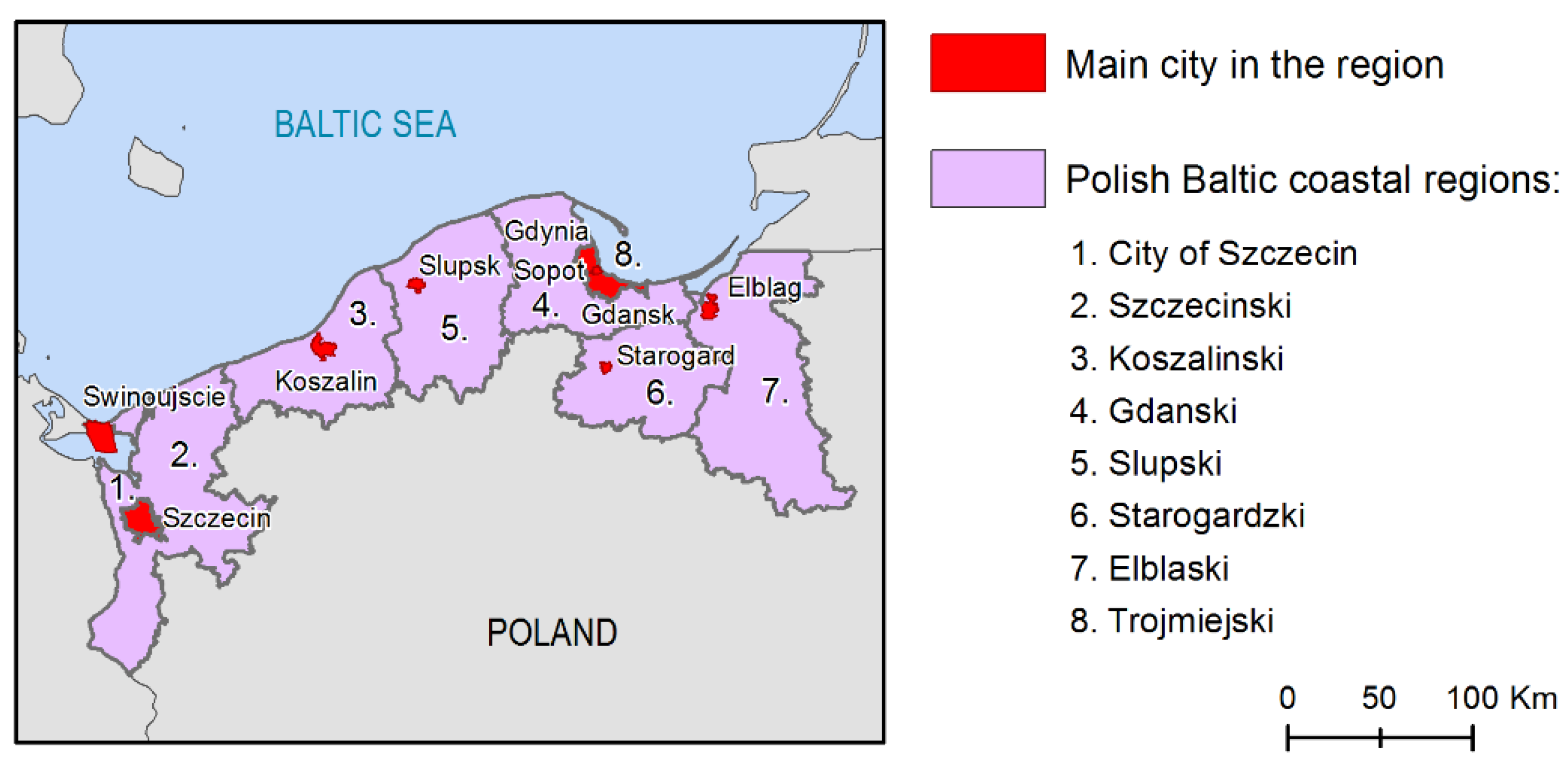
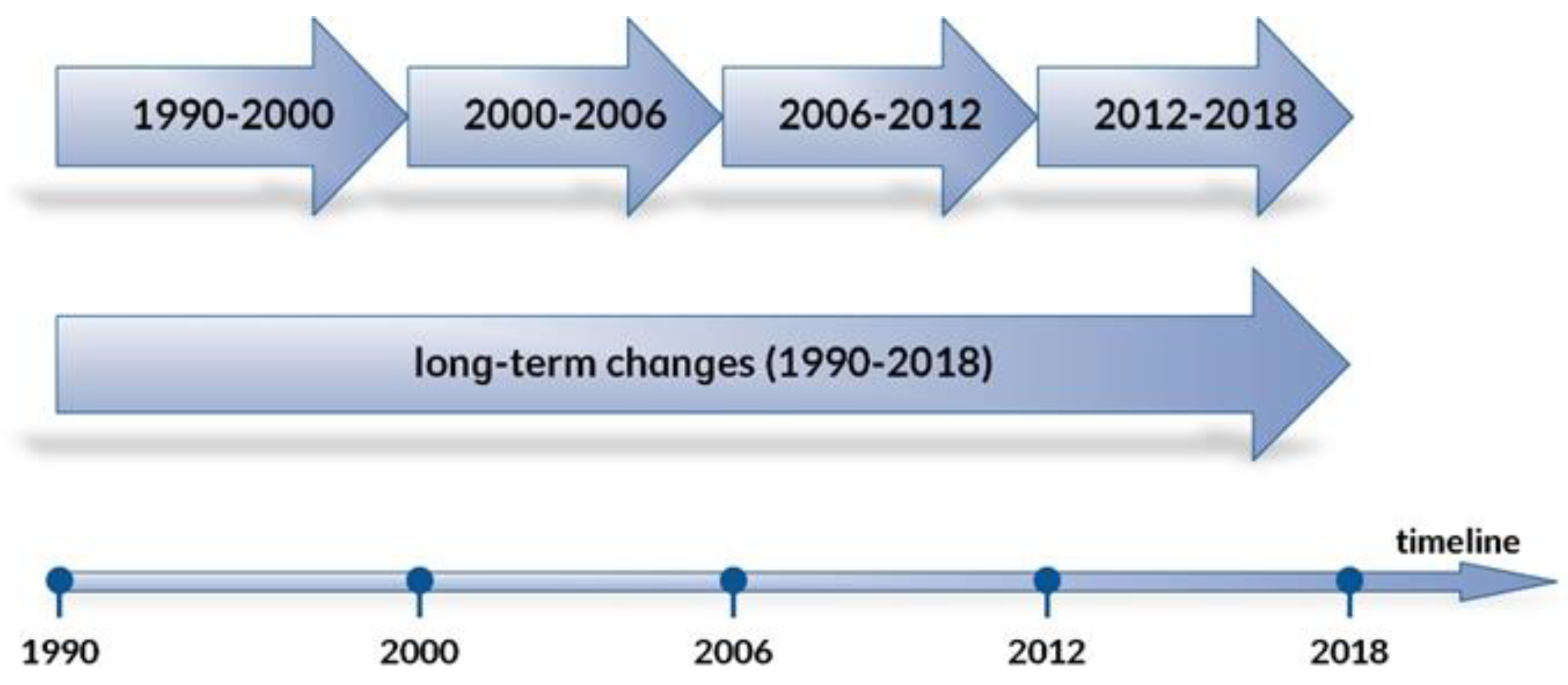
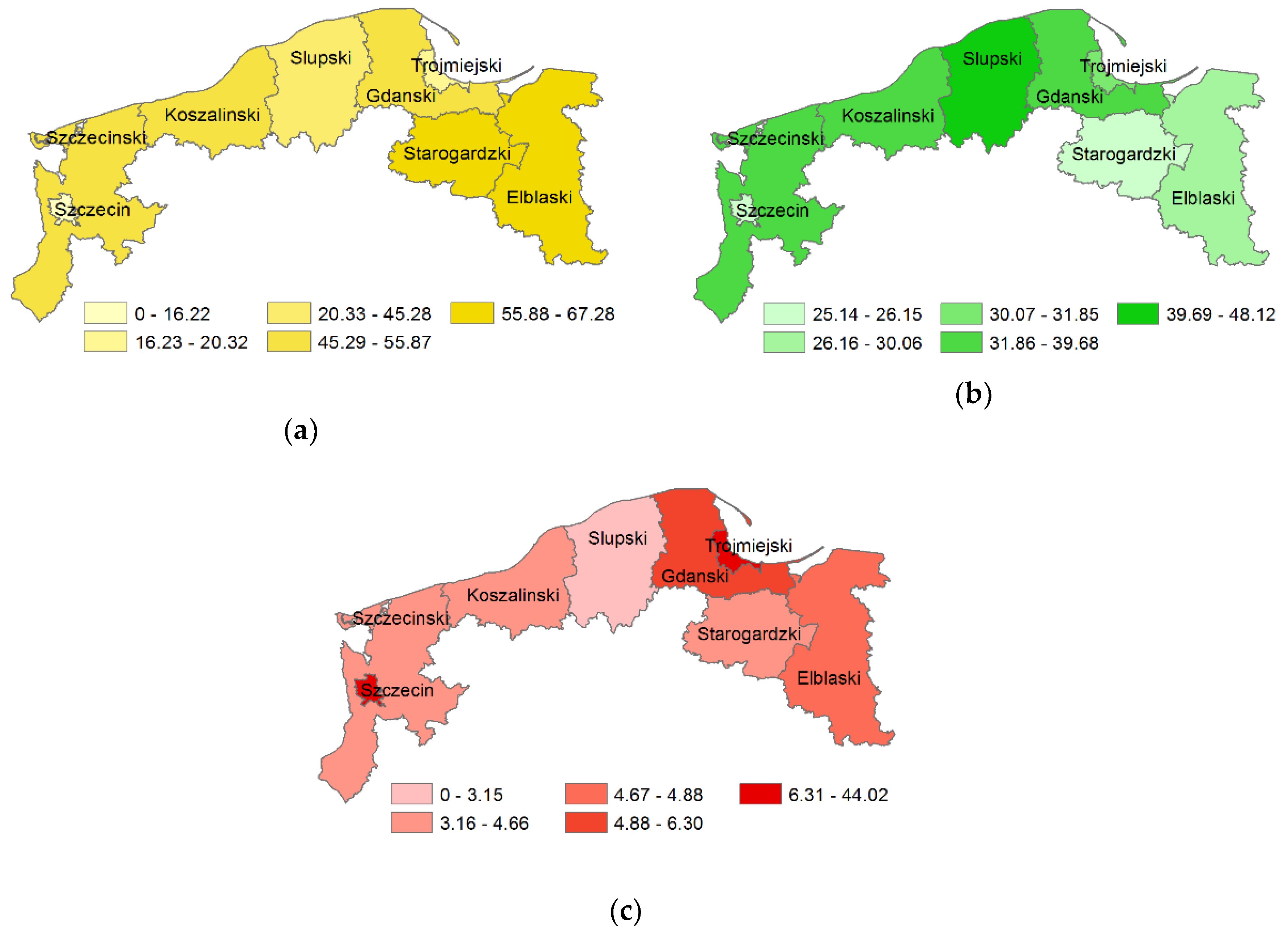

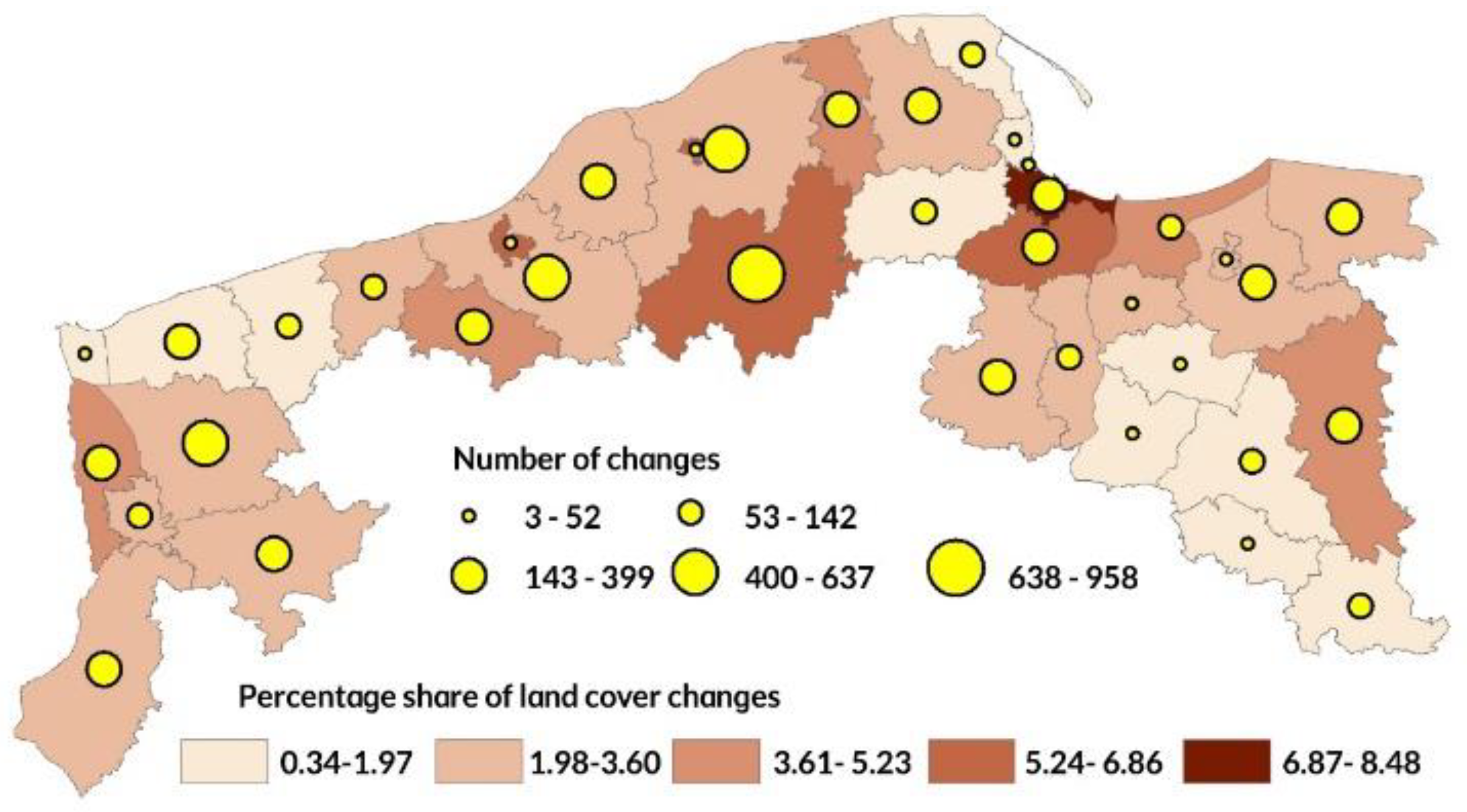

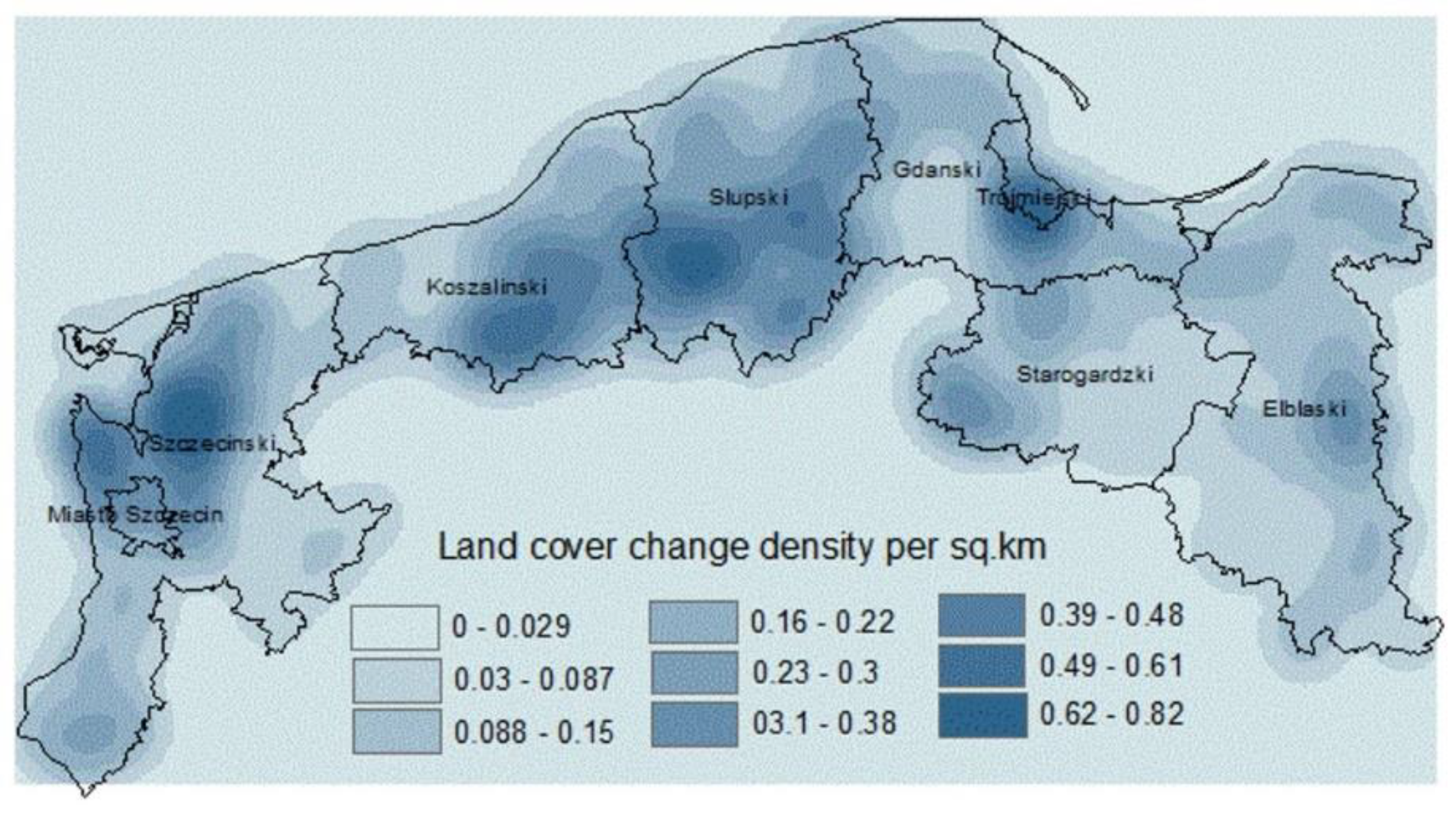
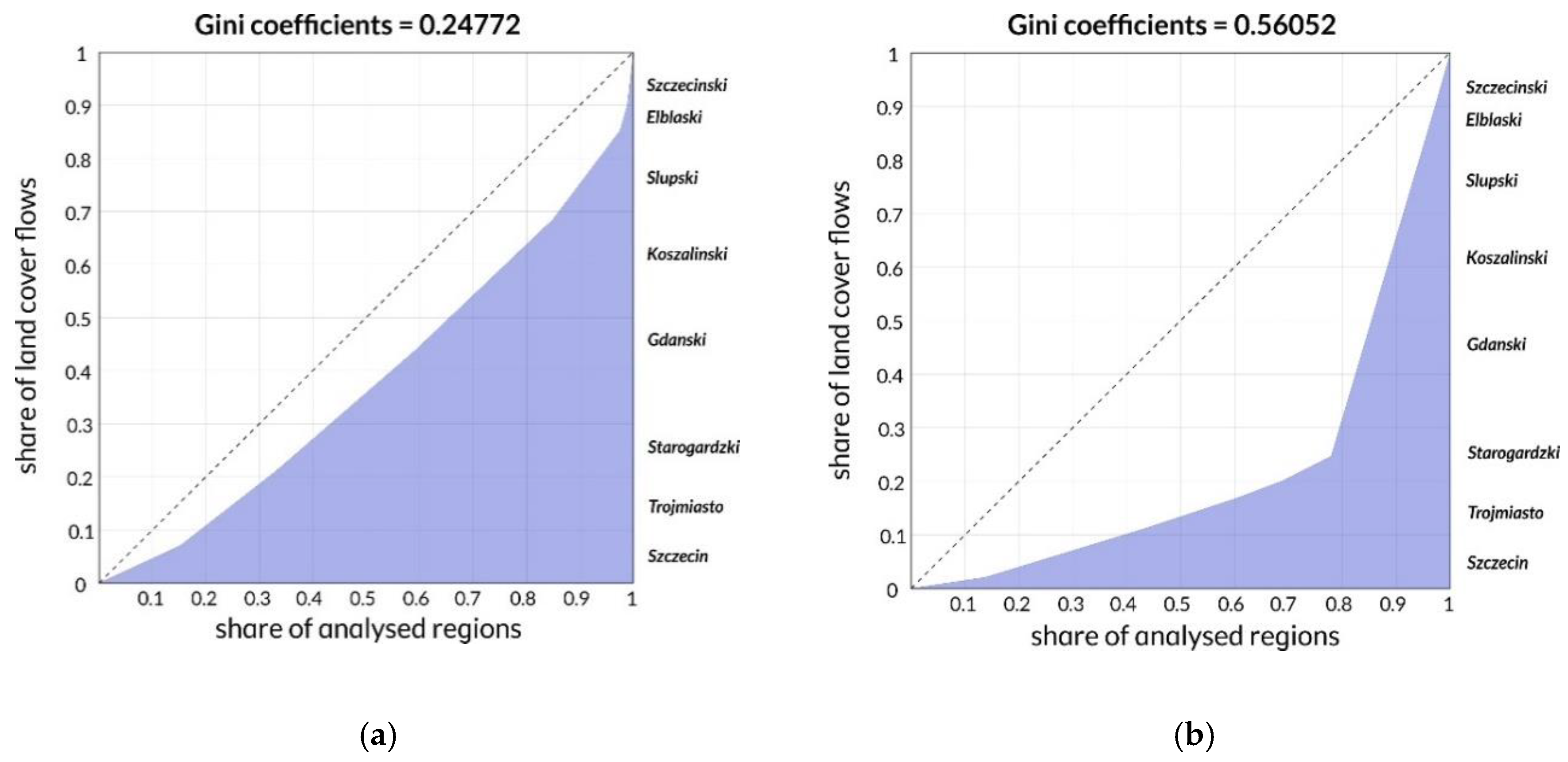
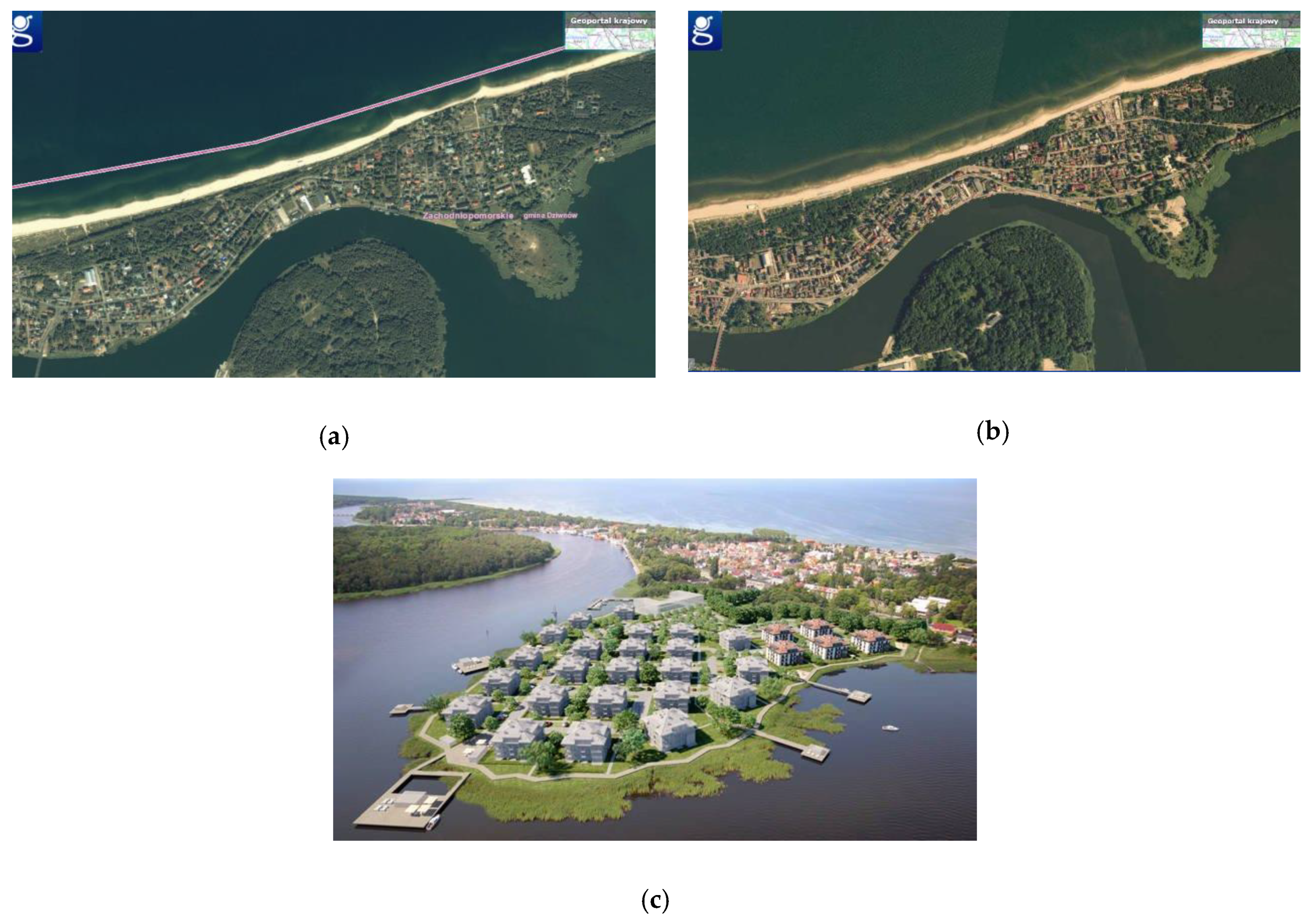


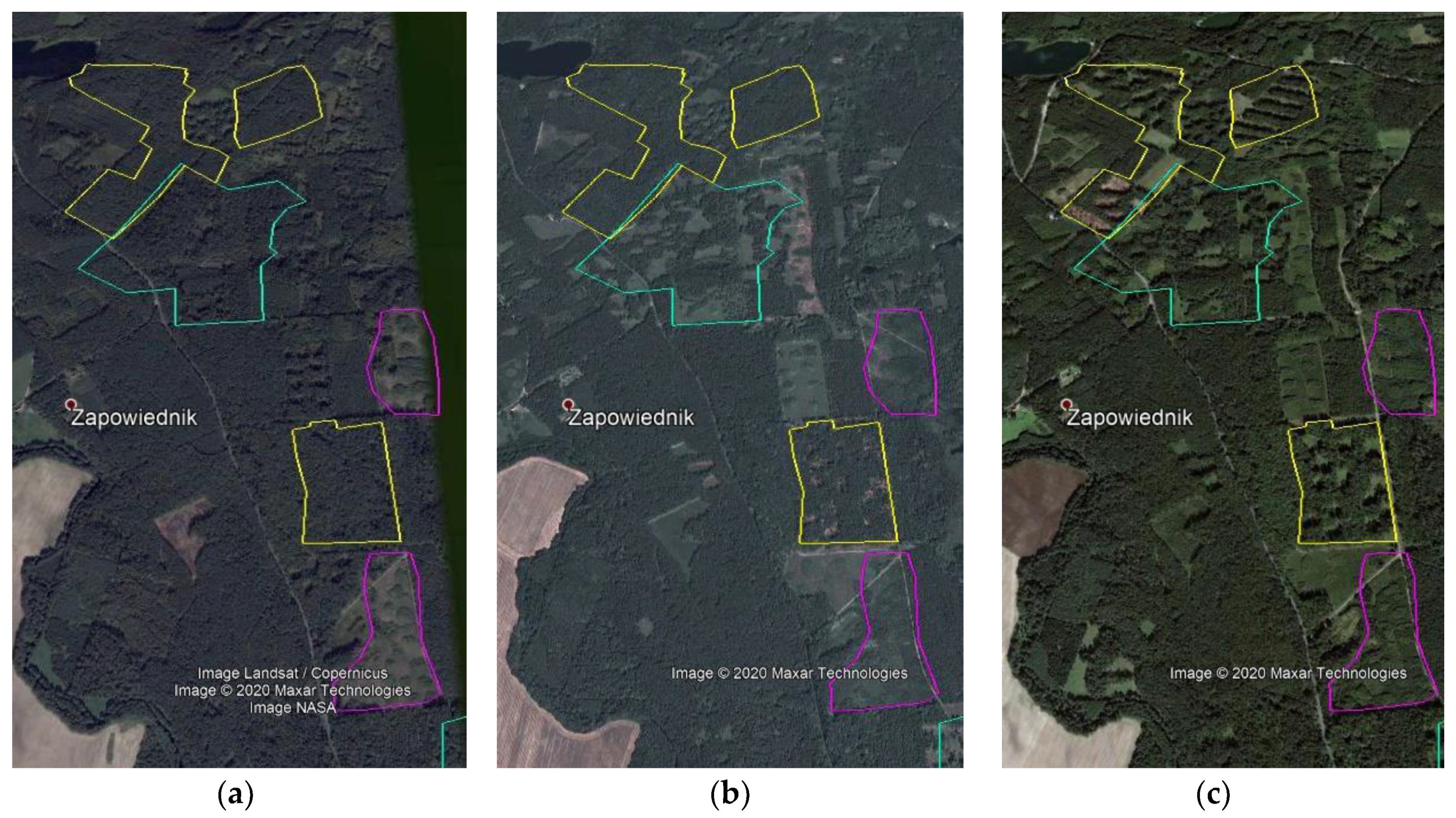

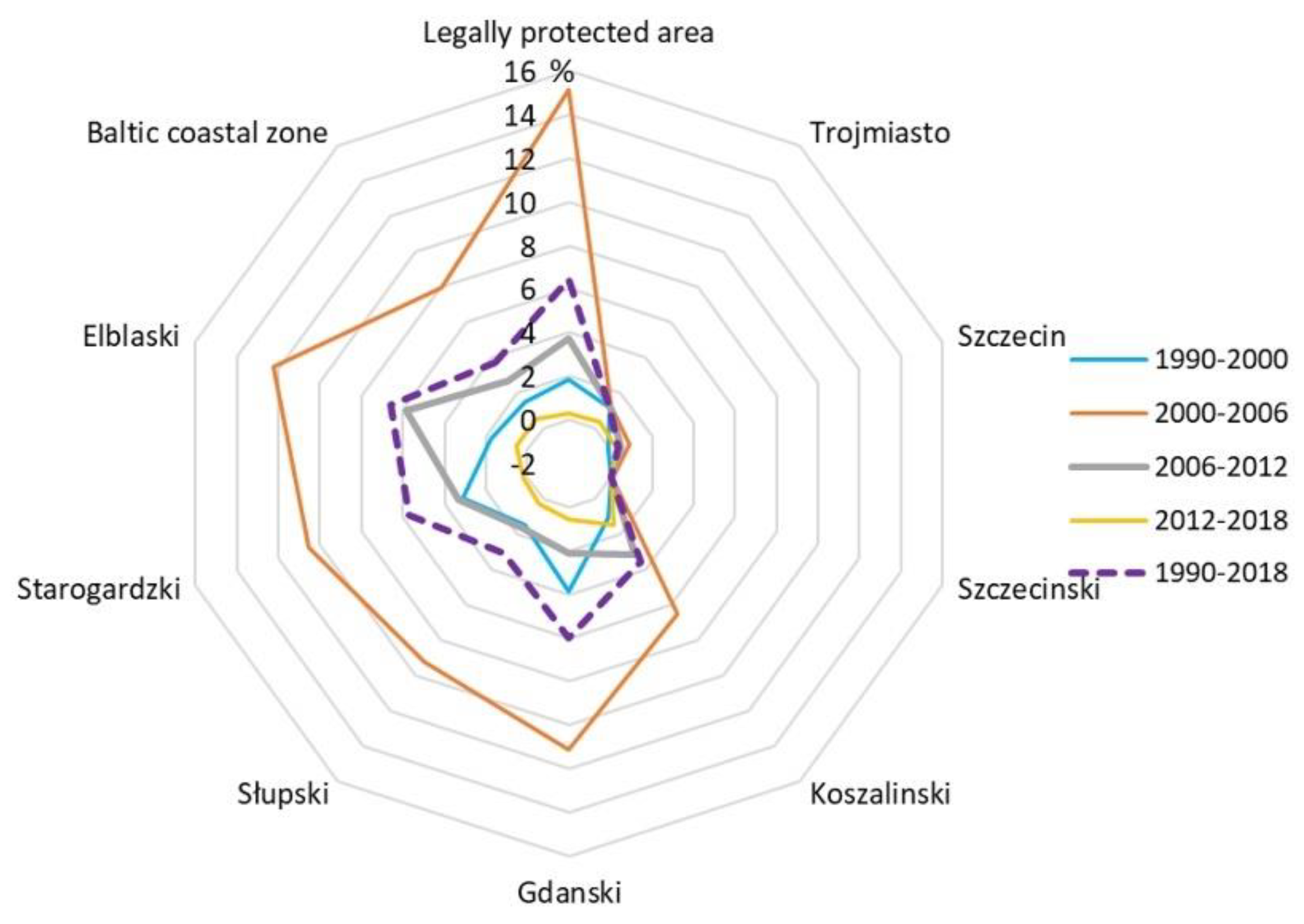
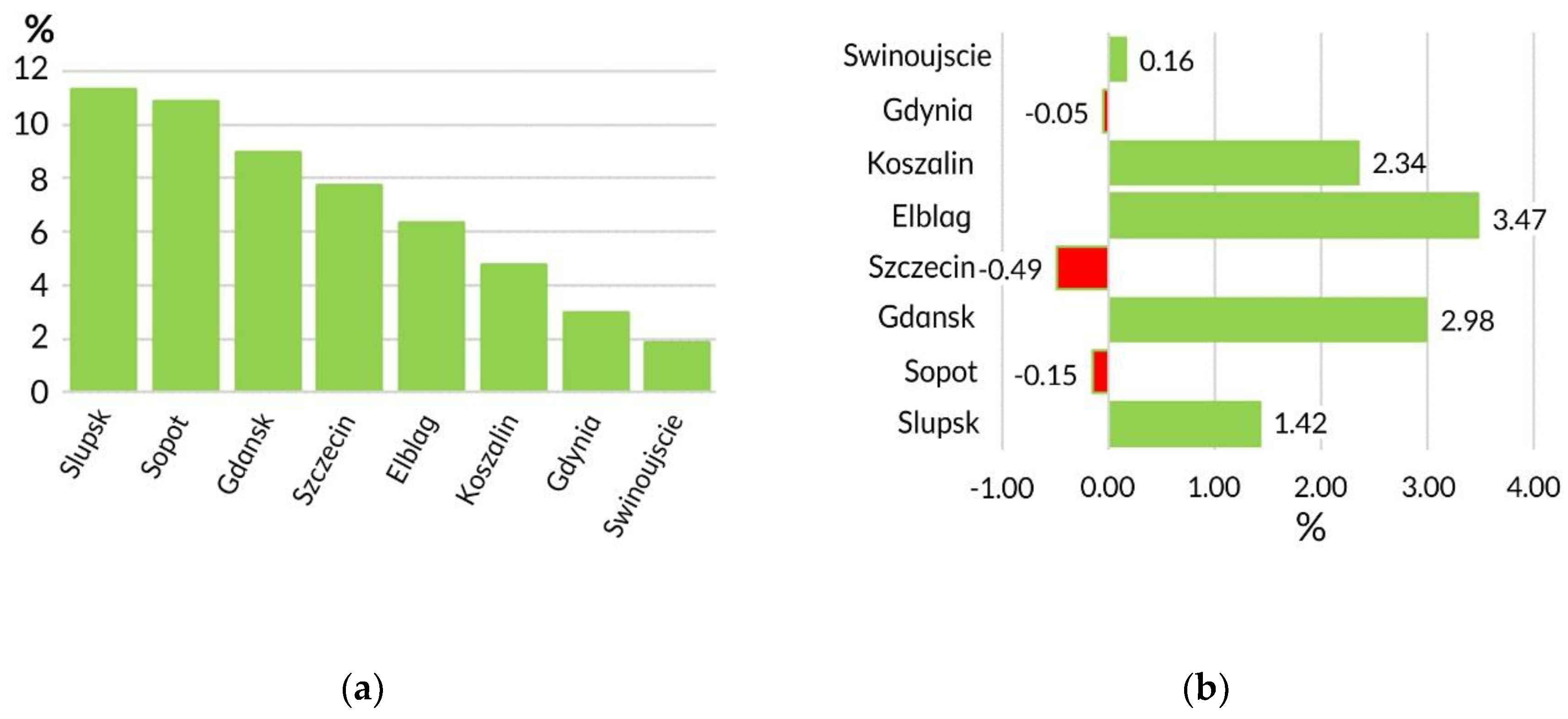
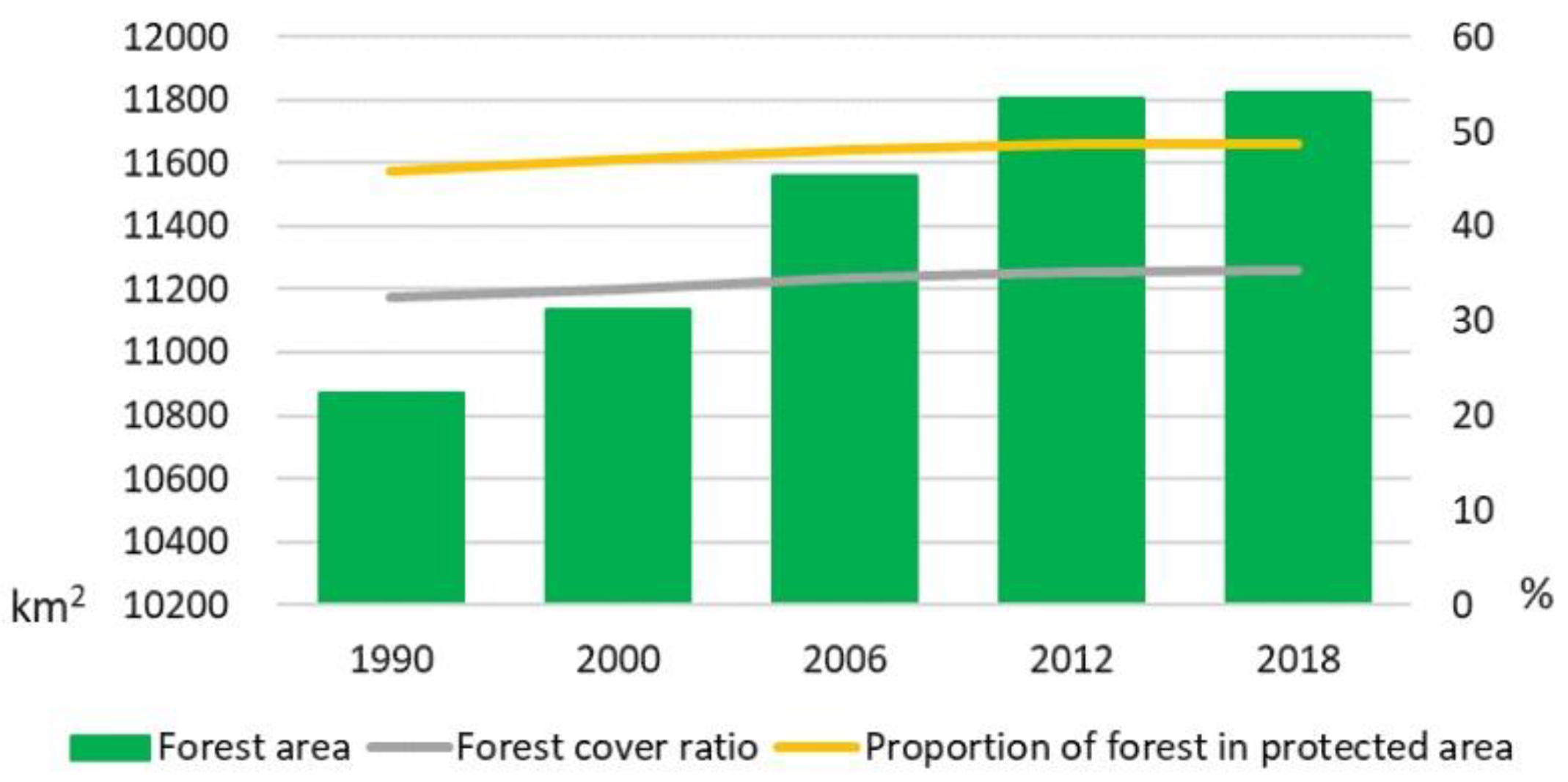
| Coastal Region (NUTS3) Names | Number of Counties 1,2 | Population Total 1 | Population Density 1 | Area [km2] |
|---|---|---|---|---|
| Elblaski | 7(1) | 526,321 | 72 | 7323.46 |
| Gdanski | 5(0) | 590,198 | 137 | 4299.30 |
| Trojmiejski | 3(3) | 748,986 | 1805 | 415.05 |
| Slupski | 4(1) | 335,402 | 64 | 5240.16 |
| Koszalinski | 5(1) | 357,478 | 82 | 4363.27 |
| Starogardzki | 5(0) | 432,488 | 106 | 4095.79 |
| Szczecinski | 7(1) | 513,412 | 69 | 7444.81 |
| City of Szczecin | 1(1) | 402,465 | 1339 | 300.50 |
| Total | 37(8) | 3,906,750 | 33,482.34 |
| Reference Year | Satellite | Temporal Extend (Poland) 1 |
|---|---|---|
| 1990 | Landsat 4/5 TM | 1986–1995 |
| 2000 | Landsat 7 ETM+ | 1990–2001 |
| 2006 | SPOT 4/5, IRS-P6 | 2005–2006 |
| 2012 | RapidEye, IRS-P6 | 2011–2012 |
| 2018 | Sentinel 2, Landsat-8 | 2017 |
| CLC Level 1 | CLC Level 2 | ||
|---|---|---|---|
| Code | Name | Code | Name |
| 1. | Artificial surfaces | 1.1 | Urban fabric |
| 1.2 | Industrial, commercial and transport units | ||
| 1.3 | Mine, dump and construction sites | ||
| 1.4 | Artificial, non-agricultural vegetated areas | ||
| 2. | Agricultural areas | 2.1 | Arable land |
| 2.2 | Permanent crops | ||
| 2.3 | Pastures | ||
| 2.4 | Heterogeneous agricultural areas | ||
| 3. | Forests and semi-natural areas | 3.1 | Forest |
| 3.2 | Scrub and/or herbaceous vegetation associations | ||
| 3.3 | Open spaces with little or no vegetation | ||
| 4. | Wetlands | 4.1 | Inland wetlands |
| 4.2 | Coastal wetlands1 | ||
| Water bodies | 5.1 | Continental waters | |
| 5.2 | Marine waters | ||
| Products | Time Horizon | Repository | Comments |
|---|---|---|---|
| Aerial orthophotomapas | 1990s, since 2000 every 2 years | Geoportal maintained by the Head Office of Geodesy and Cartography [27] | For the 1990s. data available only for Gdansk, Sopot, Szczecin; 0.25 resolution |
| Very High-Resolution Image Mosaic 2012 | 2012 | Copernicus land monitoring services [28] | True Colour (2.5m) of pan-sharpened: SPOT-5, 6 and FORMOSAT-2 |
| The HR Mosaic for 2018 | 2018 | Copernicus land monitoring services [28] | Sentinel-2 (10 m) true and false colour compositions |
| Sentinel-2 | 2018 | European Space Agency (ESA) [29] | Sentinel-2 (10 m, 20 m, 60 m); false colour compositions |
| IKONOS, QuickBird, GeoEye, WorldView, SPOT, Pleiades | Since 2000 1 | Google Earth | True-colour compositions; Very High-resolution images 2.5–5 m resolution |
| Landsat | 1990 1, 2000, 2006, 2012, 2018 | USGS Earth Explorer [30] | For 1990 partial coverage; Pansharpened images (15 m); True and false colour compositions |
| CLC Code | CLC Nomenclature | 1990 | 2000 | 2006 | 2012 | 2018 | Net Changes in 1990–2018 1 |
|---|---|---|---|---|---|---|---|
| 1.1 | Urban fabric | 1.793 | 2.138 | 3.375 | 3.899 | 3.948 | 2.155 |
| 1.2 | Industrial, commercial and transport units | 0.466 | 0.470 | 0.515 | 0.614 | 0.656 | 0.190 |
| 1.3 | Mine, dump and construction sites | 0.057 | 0.071 | 0.132 | 0.167 | 0.243 | 0.186 |
| 1.4 | Artificial, non-agricultural vegetated areas | 0.231 | 0.245 | 0.297 | 0.344 | 0.346 | 0.114 |
| 2.1 | Arable land | 44.741 | 44.664 | 43.606 | 42.680 | 42.519 | –2.222 |
| 2.2 | Permanent crops | 0.089 | 0.070 | 0.071 | 0.082 | 0.078 | –0.010 |
| 2.3 | Pastures | 8.875 | 8.416 | 8.948 | 8.774 | 8.717 | –0.157 |
| 2.4 | Heterogeneous agricultural areas | 8.105 | 7.494 | 5.369 | 4.999 | 4.975 | –3.130 |
| 3.1 | Forest | 32.146 | 32.856 | 33.153 | 33.709 | 33.573 | 1.427 |
| 3.2 | Scrub and/or herbaceous vegetation associations | 0.288 | 0.377 | 1.333 | 1.506 | 1.714 | 1.426 |
| 3.3 | Open spaces with little or no vegetation | 0.136 | 0.114 | 0.106 | 0.098 | 0.098 | –0.038 |
| 4.1 | Inland wetlands | 0.521 | 0.523 | 0.509 | 0.539 | 0.540 | 0.019 |
| 4.2 | Coastal wetlands2 | 0.000 | 0.000 | 0.000 | 0.000 | 0.000 | 0.000 |
| 5.1 | Continental waters | 2.474 | 2.482 | 2.501 | 2.506 | 2.509 | 0.034 |
| 5.2 | Marine waters | 0.080 | 0.079 | 0.086 | 0.085 | 0.084 | 0.005 |
| Total | 100 | 100 | 100 | 100 | 100 |
| Land Cover Flow | 1990–2000 | 2000–2006 | 2006–2012 | 2012–2018 | 1990–2018 |
|---|---|---|---|---|---|
| %/km2 | %/km2 | %/km2 | %/km2 | %/km2 | |
| LCF1—Urbanization | 0.059 | 0.084 | 0.164 | 0.183 | 0.49 |
| 1975.46 | 2812.52 | 5491.11 | 6127.27 | 16,406.36 | |
| LCF2—Intensification of agriculture | 0 | 0 | 0.016 | 0.03 | 0.046 |
| 535.72 | 1004.47 | 1540.19 | |||
| LCF3—Extensification of agriculture | 0.091 | 0.05 | 0.009 | 0.007 | 0.157 |
| 3046.90 | 1674.12 | 301.34 | 234.38 | 5256.73 | |
| LCF4—Afforestation | 0.208 | 0.149 | 0.301 | 0.23 | 0.888 |
| 6964.33 | 4988.87 | 10,078.19 | 7700.95 | 29,732.35 | |
| LCF5—Deforestation | 0.035 | 0.193 | 0.346 | 0.599 | 1.173 |
| 1171.88 | 6462.10 | 11,584.90 | 20,055.94 | 39,274.82 |
© 2020 by the authors. Licensee MDPI, Basel, Switzerland. This article is an open access article distributed under the terms and conditions of the Creative Commons Attribution (CC BY) license (http://creativecommons.org/licenses/by/4.0/).
Share and Cite
Bielecka, E.; Jenerowicz, A.; Pokonieczny, K.; Borkowska, S. Land Cover Changes and Flows in the Polish Baltic Coastal Zone: A Qualitative and Quantitative Approach. Remote Sens. 2020, 12, 2088. https://doi.org/10.3390/rs12132088
Bielecka E, Jenerowicz A, Pokonieczny K, Borkowska S. Land Cover Changes and Flows in the Polish Baltic Coastal Zone: A Qualitative and Quantitative Approach. Remote Sensing. 2020; 12(13):2088. https://doi.org/10.3390/rs12132088
Chicago/Turabian StyleBielecka, Elzbieta, Agnieszka Jenerowicz, Krzysztof Pokonieczny, and Sylwia Borkowska. 2020. "Land Cover Changes and Flows in the Polish Baltic Coastal Zone: A Qualitative and Quantitative Approach" Remote Sensing 12, no. 13: 2088. https://doi.org/10.3390/rs12132088
APA StyleBielecka, E., Jenerowicz, A., Pokonieczny, K., & Borkowska, S. (2020). Land Cover Changes and Flows in the Polish Baltic Coastal Zone: A Qualitative and Quantitative Approach. Remote Sensing, 12(13), 2088. https://doi.org/10.3390/rs12132088





